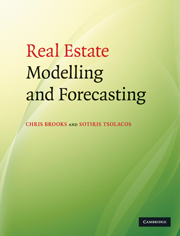Book contents
- Frontmatter
- Contents
- List of figures
- List of tables
- List of boxes
- Preface
- Acknowledgements
- 1 Introduction
- 2 Mathematical building blocks for real estate analysis
- 3 Statistical tools for real estate analysis
- 4 An overview of regression analysis
- 5 Further issues in regression analysis
- 6 Diagnostic testing
- 7 Applications of regression analysis
- 8 Time series models
- 9 Forecast evaluation
- 10 Multi-equation structural models
- 11 Vector autoregressive models
- 12 Cointegration in real estate markets
- 13 Real estate forecasting in practice
- 14 The way forward for real estate modelling and forecasting
- References
- Index
2 - Mathematical building blocks for real estate analysis
Published online by Cambridge University Press: 05 June 2012
- Frontmatter
- Contents
- List of figures
- List of tables
- List of boxes
- Preface
- Acknowledgements
- 1 Introduction
- 2 Mathematical building blocks for real estate analysis
- 3 Statistical tools for real estate analysis
- 4 An overview of regression analysis
- 5 Further issues in regression analysis
- 6 Diagnostic testing
- 7 Applications of regression analysis
- 8 Time series models
- 9 Forecast evaluation
- 10 Multi-equation structural models
- 11 Vector autoregressive models
- 12 Cointegration in real estate markets
- 13 Real estate forecasting in practice
- 14 The way forward for real estate modelling and forecasting
- References
- Index
Summary
Learning outcomes
In this chapter, you will learn how to
construct price indices;
compare nominal and real series and convert one to the other;
use logarithms and work with matrices; and
construct simple and continuously compounded returns from asset prices.
Introduction
This chapter provides the mathematical foundations for the quantitative techniques examined in the following chapters. These concepts are, in the opinions of the authors, fundamental to a solid understanding of the remainder of the material in this book. They are presented fairly briefly, however, since it is anticipated that the majority of readers will already have some exposure to the techniques, but may require some revision.
Constructing price index numbers
Index numbers are a useful way to present a series so that it is easy to see how it has changed over time, and they facilitate comparisons of series with different units of measurement (for example, if one is expressed in US dollars and another in euros per square metre). They are widely used in economics, real estate and finance – to display series for GDP, consumer prices, exchange rates, aggregate stock values, house prices, and so on. They are helpful in part because the original series may comprise numbers that are large and therefore not very intuitive. For example, the average UK house price according to the Halifax was £132,589 in 2004 rising to £165,807 in 2006. Does this represent a large increase? It is hard to tell simply by glancing at the figures.
- Type
- Chapter
- Information
- Real Estate Modelling and Forecasting , pp. 21 - 40Publisher: Cambridge University PressPrint publication year: 2010



